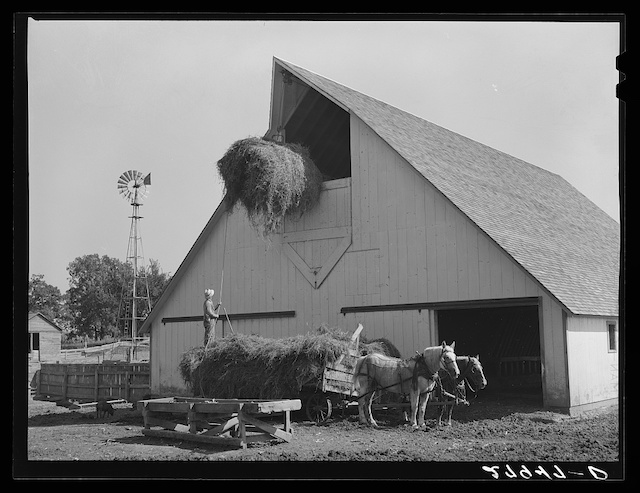
Jasper County farmer Ernest Maxwell filling his hayloft in 1939. Photograph by Arthur Rothstein, retrieved from the Library of Congress, https://www.loc.gov/item/2017778174/
March/April 2023 (Volume 15, Issue 2)
By Clark BreDahl
On our way into town the other day, my wife Lyn and I topped a hill a couple of miles north of our house in Adair County and I nearly drove off in the ditch. The huge, curved roof barn that had stood as a proud landmark for more than my lifetime was gone — I mean gone without a trace!
I had to pull over to the side of the road and stop for a moment to take it all in. I had just been by the place a few days before and noticed a large track-hoe sitting in the yard that had removed a row of dead evergreens stripped by the hail storm earlier this spring. But, it never dawned on me then that that straight, square, majestic, old barn would soon be next to go.
The rest of the trip into town that morning was me jabbering to Lyn about all the time I spent stacking hay in that barn as a kid. My 4-H club leader lived there and one of his lanky, athletic sons was 6-feet-5-inches tall in his stocking feet and good with a ball in his hands. So, it wasn’t a huge surprise when I saw that the empty loft had basketball hoops at both ends along with clearly marked free-throw stripes. The downside of seeing that was the stark realization that you were soon going to help stack approximately 3,000 small square bales of hay to the peak of that barn.
As the shock gradually wore off, it started me thinking of other barns in the neighborhood that I had once worked in during my “professional” hay-making days in high school. And once again, I lapsed into shock. Thirteen of those barns that I spent time in were gone completely! Only four still stand today.
One of the barns still standing is our own. In 1953, it was probably one of the last loft-style barns built. My dad was so proud of it following completion that he invited all the neighbors in to celebrate with a barn dance.
Most of the barns in our area at that time were built prior to 1930. No one could afford a new barn after the Great Depression hit, and, following that, World War II intervened. Those early barns were built with stalls to accommodate draft horses and milk cows, lofts to accommodate loose hay, mangers to feed it in and hay chutes to fork it down.
As draft horses quickly left the scene following the war, the stalls increasingly were used to house beef cattle and a few hogs. And, as hay balers, both small square and round, gained popularity, loft barns maintained their usefulness as farmers discovered they could pack a lot more baled hay into them than loose.
My generation probably had more experience putting bales into those old barns than any other. But, as they grew older, Baby Boomers began to seriously question the wisdom of climbing a steep ladder to physically drag all of those bales out again to feed. Finally, in 1971, Gary Vermeer drove the last nail into those old, wooden loft-style barns as his first large round baler rolled off an assembly line in Pella.
TO READ THE ENTIRE STORY AND OTHER FASCINATING STORIES ABOUT IOWA HISTORY, subscribe to Iowa History Journal.
